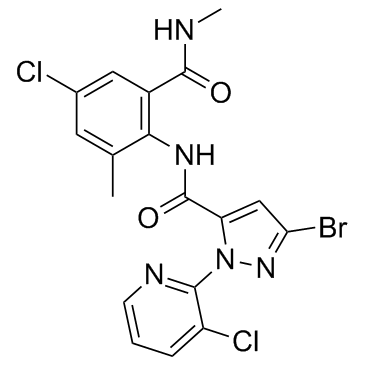| Cas No.: | 500008-45-7 |
| Chemical Name: | Chlorantraniliprole |
| Synonyms: | Chlorantraniliprole;3-Bromo-N-[4-chloro-2-methyl-6-[(methylamino)carbonyl]phenyl]-1-(3-chloro-2-pyridinyl)-1H-pyrazole-5-carboxamide;3-Bromo-4-chloro-1-(3-chloro-2-pyridyl)-2-methyl-6-(methylcarbamoyl)pyrazole-5-carboxanilide;Chlorantraniliprole [iso];Rynaxpyr;Chlorantranilipol;5-bromo-N-[4-chloro-2-methyl-6-(methylcarbamoyl)phenyl]-2-(3-chloropyridin-2-yl)pyrazole-3-carboxamide;CHLOANTRANILIPROLE;Chlorantraniliprole Standard;CHLORANTRANILIPROLE,IN-HOUSE STANDARD;3-bromo-4’-chloro-1-(3-chloro-2-pyridyl)-2’-methyl-6’-(methylcarbamoyl)pyrazole-5-carboxanilide;3-bromo-N-[4-chloro-2-methyl-6-(methylcarbamoyl)phenyl]-1-(3-chloropyridin-2-yl)-1H-pyrazole-5-carboxamide;3-bromo-N-[4-chloro-2-methyl-6-[(methylamino)carbonyl]phenyl]-1-(3-chloro-2-pyridinyl)-1H-pyrazole-5-car |
| SMILES: | O=C(C1=CC(Br)=NN1C2=NC=CC=C2Cl)NC3=C(C(NC)=O)C=C(Cl)C=C3C |
| Formula: | C18H14N5O2Cl2Br |
| M.Wt: | 483.14606 |
| Purity: | >98% |
| Sotrage: | 2 years -20°C Powder, 2 weeks 4°C in DMSO, 6 months -80°C in DMSO |
| Description: | In Vitro Chlorantraniliprole is an insecticide that potently and selectively activates insect ryanodine receptor. Chlorantraniliprole actions by release of intracellular Ca2+ stores mediated by the ryanodine receptor. Chlorantraniliprole is ∼300-fold less potent against ryanodine receptor (RyRs) in the mouse myoblast cell line, C2C12 (EC50, 14 μM), than in insect RyRs from Drosophila melanogaster and H. virescens (EC50, 40 nM, 50 nM), and shows little selectivity at the rat cell line RyR2 (EC50, >100 μM). In Vivo Chlorantraniliprole has low acute mammalian toxicity with an acute oral LD50 of >5000 mg/kg in rats, and little to no toxicity in 90-day studies, at dosing as high as 1500 mg/kg/day. |

 To enhance service speed and avoid tariff delays, we've opened a US warehouse. All US orders ship directly from our US facility.
To enhance service speed and avoid tariff delays, we've opened a US warehouse. All US orders ship directly from our US facility.




















